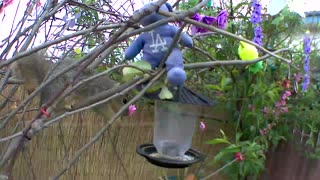Dove Bird Scavenge for Food
A beautiful mountain bird in some green grass by the roadside in Sands Complex is on the hunt and is scavenging for food that it finds in the grassy field.
Usually, doves are smaller members of the family, while pigeons are larger. There are over 300 different species of pigeons and doves.
Description of the Dove
Most doves have relatively stout bodies, with short legs and short beaks. They all have a similar shape, though their plumage varies drastically from species to species. Some doves are uniform in colour, while others have many different colours and patterns.
Their colouration also varies drastically in brightness. For example, the African-collared dove is a uniform tan colour, while the pink-headed fruit dove has a bright pink head and neck, a white collar, and a green body.
Interesting Facts About the Dove
There are simply too many different dove species to possibly highlight all of the coolest types. However, we will do our best to pick the most unique species around!
Luzon Bleeding Heart – No, this bird isn’t a hopeless romantic, it looks like its heart is bleeding. The front of this bird’s chest has a bright red smear that looks just like blood. These birds live on a few small islands in the Philippines.
Victoria Crowned Pigeon – Ok, while this species isn’t technically a dove, they are in the same family and you would regret not checking them out! Victoria crowned pigeons are the largest members of the Columbidae family at a whopping seven pounds! They are bright blue, with a beautiful crown of white-tipped feathers on the top of their heads.
Rose-Crowned Fruit Dove – This species isn’t wearing a tiny fashionable hat, that’s the colour of its head! These birds have bright pink “caps” on the tops of their heads. The rest of their plumage is a veritable Picasso painting of pinks, oranges, yellows, and greens.
Polynesian Ground-Dove – These little birds are unfortunately on the brink of extinction. The IUCN lists this species as Critically Endangered and estimates that its population contains fewer than 150 individuals in the wild. These birds are a perfect example of how invasive species can decimate island populations. Human-introduced rats, cats, and ants kill the birds and also eat their eggs and chicks.
Habitat of the Dove
Doves live in a wide variety of different habitats, from tropical rainforests to deserts. Different species usually live in different ecosystems. Some species live only in the rainforests of Brazil, while others live across meadows and grasslands of North America.
These birds inhabit swamps, savannas, woodlands, atolls, islands, mountains, deserts, and more. Many species also live in urban areas, like parks, gardens, farms, and cities.
Distribution of the Dove
These birds inhabit nearly every landmass on Earth, except for Antarctica, some areas of the Sahara desert, and the northernmost reaches of the Arctic Circle. They are a varied and diverse group of birds.
Some species live across massive expanses of land, while others inhabit a tiny area of an island or group of islands. There are dove species throughout North, Central, and South America, as well as Eurasia, Africa, Australia, and the surrounding islands.
Diet of the Dove
Most dove species are herbivores and eat primarily plant matter. Their exact diet varies based on the species and region that they live in. Some doves eat primarily fruits and berries, while others eat seeds and grains.
Those that feed on grains and seeds usually forage on the ground, while those that eat fruit typically forage in the trees and bushes. Some species also eat insects and other invertebrates, like spiders, flies, moths, snails, and more.
-
 1:37
1:37
Expert Videos Magnetic Media
2 years agoDolphin kisses a little girl and brings her a gift
39344 -
 0:30
0:30
Gemineyez
3 years agoBird Food Time
17 -
 1:36:32
1:36:32
The Quartering
9 hours agoTrump Threatened With Jail, Legal Ramifications Of Campus Commies & More With Ron Coleman
77.6K65 -
 1:37:32
1:37:32
2 MIKES LIVE
15 hours ago#62 2ML Join us to breakdown all the news worth mentioning!
39.5K15 -
 1:52:59
1:52:59
The Big Mig™
1 day agoTommy Victorious Robinson, Round II
34.5K27 -
 2:03:19
2:03:19
Quite Frankly
11 hours ago"From IN-SHADOW to the KINGDOM" ft Lubomir Arsov 5/6/24
34.3K10 -
 1:04:40
1:04:40
vivafrei
9 hours agoTrump in Contempt - AGAIN! NY Senator Sued Under His Own Law! AND MORE! Viva Frei Live
65.1K81 -
 41:56
41:56
Kimberly Guilfoyle
12 hours agoFrom the Courtroom to Campus, Left-Wing Corruption Spirals Out of Control, Live with Kash Patel & Eyal Yakoby | Ep. 123
52.5K58 -
 1:30:31
1:30:31
Redacted News
11 hours agoHere we go! Putin WARNS of nuclear test launches, NATO readies for war | Redacted w Clayton Morris
125K286 -
 1:58:09
1:58:09
Revenge of the Cis
10 hours agoEpisode 1340: Stress Eating
49.6K27